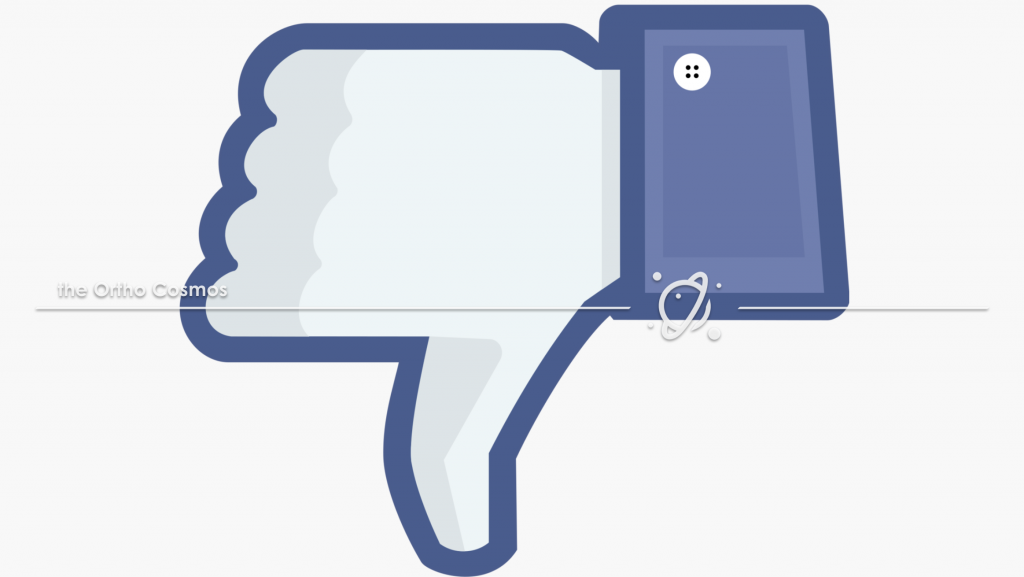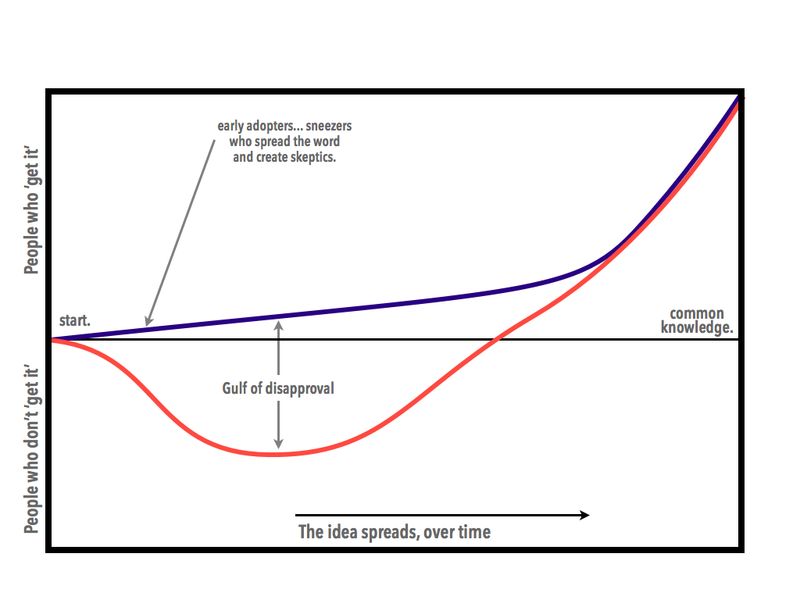Since Invisalign started 20 years ago, the product has made a large increase in the orthodontic marketshare. Despite the popularity of the appliance amongst patients, its utilization in the orthodontic market still hovers under 20%. Based on a conservative estimate that 60% of orthodontic cases can be treated with aligners, that obviously leaves room for growth of the aligner market. If this were a poll, we could consider that 20% market share, out of a 60% opportunity leaves Invisalign with a 33% approval rating. Or said differently, a 66% disapproval rating amongst the orthodontic community.
It is interesting to me seeing that all new ideas start with resistance. Seth Godin, the author of books like The Purple Cow, blogs regularly and shared a concept he calls the gulf of disapproval. In his post, he discussed how new ideas and innovations (like Invisalign) begin to see resistance but continue to gain acceptance as the early adopters and believers gain from the value added by implementing this new idea. With persistance, this new idea becomes common knowledge and gains acceptance. In my opinion, Invisalign is still within the gulf of disapproval.
Gulf of Disapproval – by Seth Godin
Why do orthodontists resist using Invisalign on their patients and why do they disapprove of this treatment modality? Let’s review the top three reasons I hear orthodontists resisting the use of aligners in their practice.
#1 – It’s too expensive
The lab fee for aligners from Invisalign is undeniably more expensive than the cost of a set of brackets. The technology and intellectual property from Align Technology still commands a large fee for this treatment. If doctors continue to use aligners in the same way they treat their braces patients: with 6-8 week appointment intervals, PVS impressions, and extended treatment times, then yes, it is an expensive appliance. The business challenge I see amongst many orthodontists is that you have to consider a different practice model to have a profitable practice with Invisalign. You can’t leverage digital technology using analog methods. A digital system is most efficient with a digital workflow. Also, missing out on the time efficiencies afforded by a product that gives start to finish control of the treatment process are critical to saving on other office expenses that counterbalance the increase in lab fees. My other observation is that aligner therapy opens the opportunity for orthodontists to expand their patient base, appealing to patients who will never consider braces for treatment. By implementing aligners, practices expand their patient flow and don’t cannibalize on the patients who want braces. The price of losing an opportunity to grow and help more people is definitely too expensive.
#2 – It doesn’t work
Early comparison studies showed a decreased effectiveness of aligners compared to fixed appliances*. Since Invisalign is a technology development, I accept that the appliance was far less effective than it is today. More recently studies are now showing no significant difference in outcomes with fixed appliances therapy*. With the ability to treat cases with the same outcome as braces, the advantages in patient experience and clinical efficiencies make aligners a preferable modality. The key limiting factor is that the appliance by itself does not treat cases. It has the potential for success, but the critical piece of the puzzle is that the doctor has to have the skills to treat cases effectively and take control of the clincheck process. Like they say… practice makes perfect. Millions of people have been treated with Invisalign, and so many of them are complex cases treated with remarkable outcomes.
#3 – Patients won’t wear it
Compliance in orthodontic treatment is a common pain point used as a stumbling block for recommending aligners to patients. This excuse is either based on fear of depending on a fully compliance based appliance, or a consequence of practices that don’t have proactive systems to foster patient compliance. Fortunately, there are ways to improve on this potential problem. For aligner patients, there is more leverage for compliance than other treatment modalities. Ultimately, being proactive promoting proper use of the appliances is key to avoid this potential pitfall.
Disapproval continues to be common with aligner therapy. As we acknowledge the three areas of resistance, I believe many opportunities lie ahead for the integration of this not so new digital process.
* References:
- Djeu, et al. Outcome assessment of Invisalign and traditional orthodontic treatment compared with the American Board of Orthodontics objective grading system. AJODO 2005 Sep; 128(3):292-298.
- Kravitz, et al. How well does Invisalign work? A prospective clinical study evaluating the efficacy of tooth movement with Invisalign. AJODO 2009 Jan;135(1):27-35.
- Li, et al. The effectiveness of the Invisalign appliance in extraction cases using the ABO model grading system: a multicenter randomized controlled trial. Int J Clin Exp Med. 2015 May 15;8(5):8276-82. eCollection 2015.


Reason number 4
Open posterior bites!!
Good add Randall. Time will tell if the G7 tools added to address posterior open bites will reduce this common side effect.